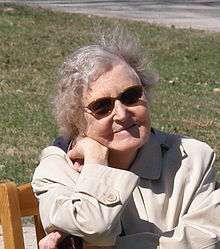Ilse Lehiste
Ilse Lehiste (31 January 1922 – 25 December 2010) was an Estonian-born American linguist, author of many studies in phonetics.
| Ilse Lehiste | |
|---|---|
 Ilse Lehiste in 2009 | |
| Born | 31 January 1922 |
| Died | 25 December 2010 |
Early life
Ilse Lehiste finished high school in Tallinn and studied piano playing at the Conservatory. In 1942 she began her studies at the Faculty of Philosophy at the University of Tartu. In 1944 she moved to Germany, where she continued her studies – while working for her keep – at the universities of Leipzig and Hamburg, and obtained a doctoral degree at the University of Hamburg. Her thesis dealt with the work of William Morris, in particular the part concerning Nordic literature. In 1949 she moved to the United States where she defended her second doctoral thesis – this one about linguistics – at the University of Michigan.
Academic life and work
She worked at the University of Hamburg, Kansas Wesleyan University, the Detroit Institute of Technology, and the University of Michigan.[1] Finally, at the Ohio State University, she was as associate professor from 1963 and full professor from 1965. Her main fields of research were acoustic phonetics and phonology, prosody, language contacts, Estonian and Serbo-Croatian. In particular, she has done valuable research work on Estonian phonetics. She was also interested in Estonian runic songs and, in collaboration with Jaan Ross, published several works on this topic.
She did much to make Estonia and Estonian known in the United States and elsewhere in the world. During the Soviet occupation of Estonia, she helped to mediate research papers between Estonia and the free world. It was also thanks to her that the 11th International Congress of Phonetic Sciences (ICPhS) in 1987 was arranged in Tallinn. More than 700 phoneticians from 35 countries participated in the Congress.
Her papers, including many spectrograms, are archived at the American Philosophical Society.[2]
Honors and functions
Honorary doctor at University of Essex, Lund University, University of Tartu and Ohio State University.
Foreign member of the Finnish Academy of Science and Letters and of the Estonian Academy of Sciences.
President of the Association for the Advancement of Baltic Studies (AABS) (1974-1976)
President of the Linguistic Society of America (1980)
Medal for Scientific Achievement, International Speech Communication Association, 2002.[3]
Bibliography
Ilse Lehiste wrote 11 books and almost 300 research papers and criticism. She was also co-author of books and articles and acted as editor.
Ilse Lehiste. Segmental and Syllabic Quantity in Estonian. American Studies in Uralic Linguistics, vol. 1. Bloomington: Indiana University. (1960)
Ilse Lehiste. Suprasegmentals. (1970) Cambridge, Massachusetts: MIT Press
Ilse Lehiste. Readings in Acoustic Phonetics. (1977) Cambridge, Massachusetts: MIT Press
Ilse Lehiste & Pavle Ivić. Word and Sentence Prosody in Serbocroatian. (1986) Cambridge, Massachusetts: MIT Press
Ilse Lehiste. Lectures on Language Contact. (1988) Cambridge, Massachusetts: MIT Press
Jaan Ross & Ilse Lehiste. The Temporal Structure of Estonian Runic Songs. (2001) Berlin: Mouton de Gruyter
References
- Johnson, Keith (March 30, 2011). "Ilse Lehiste" (PDF). UC Berkeley Phonology Lab Annual Report (2011). Phonology Laboratory, University of California, Berkeley. pp. 1–8. Retrieved 16 December 2013.
- "Ilse Lehiste Papers, American Philosophical Society". Retrieved May 8, 2019.
- "ISCA (International Speech Communication Association) Honors and Awards". Retrieved Mar 22, 2018.